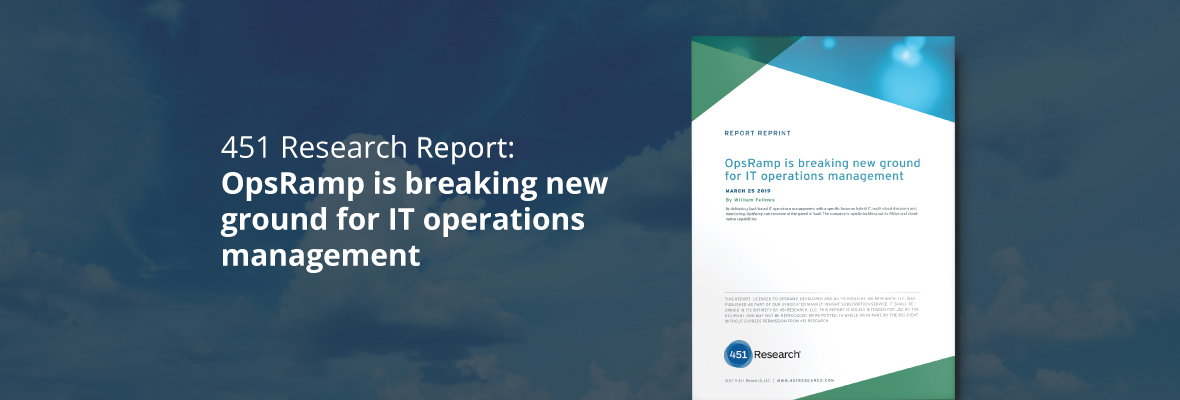451 Research analyst, William Fellows, recently authored a Market Impact report titled, OpsRamp is breaking new ground for IT operations management. The report analyzes our latest platform features and innovations for hybrid cloud management use cases. According to the report, OpsRamp is one of the few modern ITOM platforms that combines monitoring, event analytics and incident management so that enterprise IT teams can use it as “a destination for hybrid IT operations management and cloud.”
According to the report, the biggest differentiator for the OpsRamp platform lies in its ability to discover “the topology of an application, tagging it to a service, having the infrastructure provisioned automatically whether it's on-premises or in the cloud and then monitoring and managing it brings a whole new expectation for ITOM compared with what has existed so far.” The report goes on to review three key platform highlights from our January 2019 release:
#1 - Transforming the World of Legacy ITOM with a Modern SaaS Platform.
 While some analysts have predicted the impending demise of corporate datacenters, legacy technologies have a funny way of sticking around. Today’s digital transformation initiatives center around unleashing dynamic and responsive IT services built on a mix of on-prem, private cloud and public cloud infrastructure. While OpsRamp can monitor and optimize 100+ cloud services from public cloud providers like Amazon Web Services, Microsoft Azure and Google Cloud Platform, the platform also delivers robust management capabilities for existing on-prem compute, storage and network infrastructure.
While some analysts have predicted the impending demise of corporate datacenters, legacy technologies have a funny way of sticking around. Today’s digital transformation initiatives center around unleashing dynamic and responsive IT services built on a mix of on-prem, private cloud and public cloud infrastructure. While OpsRamp can monitor and optimize 100+ cloud services from public cloud providers like Amazon Web Services, Microsoft Azure and Google Cloud Platform, the platform also delivers robust management capabilities for existing on-prem compute, storage and network infrastructure.
More importantly, legacy ITOM vendors have failed to upgrade their tool portfolios to reflect the growing importance of hybrid IT, multi-cloud operations and cloud-native management in the enterprise landscape. Given the declining market presence of the traditional Big 4 vendors, OpsRamp’s service-centric AIOps platform delivers a unified service experience across both legacy and modern workloads. The 451 report comments on how OpsRamp plans to take on the challenge of modernizing legacy ITOM suites: “It is hoping to swap out laggard incumbents still rotating to 'the new' and leaving their installed bases vulnerable as they seek modern ITOM platforms.”
#2 - How Service-Centric AIOps is Addressing The Age-Old Problem of Event Correlation and Analysis.

Diagnosing and restoring IT outages has always been about making sense of the root cause(s) behind a service disruption, informing the right teams about the incident and then actually fixing the issue. The promise of machine-learning powered prediction techniques for event correlation is all about reducing the time it takes to make an informed decision on detecting, understanding and analyzing the business impact of an IT outage.
OpsRamp’s service-centric AIOps combines the ability to marry IT service context across dynamic and distributed IT infrastructure workloads, so that application owners and service delivery teams can minimize downtime and drive faster issue resolution with the right event insights. Service maps in OpsRamp help IT teams track real-time hybrid infrastructure dependencies for modern digital services with inline visualization and dynamic topology views: “The service map's UI identifies underlying resources behind an IT service outage so that operations teams can home in on the right course of action to restore services.”
OpsRamp also offers three specific inference models for IT event management and innovative features like auto-incident creation, augmented training for improved ML-prediction and frequency-based alert escalation for issue prioritization and reduced business disruption. 451 Research explains how service-centric AIOps ensures improved anomaly detection, better service health and relevant insights: “Correlating alerts that are related to the same issue enables the product to automatically reduce alert volumes by eliminating alerts that the system has learned aren't meaningful because, for instance, an anomaly happens every week at the same time and doesn't require a response.”
#3 - Embrace Rapid Experimentation and Continuous Innovation With Cloud Native Management.

The 2018 IDG Cloud Computing survey found that 73% of enterprises plan to use cloud-based applications and computing for their digital services delivery. The adoption of public cloud infrastructure and platform services is transforming how developers design, build, and operate modern IT services. Cloud native technologies like agile microservices and containerized deployments ensure operational flexibility, faster time-to-market, and resilient infrastructure.
OpsRamp’s cloud native monitoring and management capabilities received a boost when we joined as a silver member of the Cloud Native Computing Foundation this January. We also announced the availability of modern container infrastructure monitoring, with support for both on-prem and managed Kubernetes environments. The report states how OpsRamp delivers end-to-end visibility and control for cloud native architectures: “It can now discover and monitor Kubernetes environments across on-premises and cloud services such as Azure Kubernetes Services, Google Kubernetes Engine and Amazon Elastic Container Service for Kubernetes.”Next steps:
- Read our latest white paper, Transformation Without Trepidation: Simplifying Cloud Migration With OpsRamp.
- Learn why 451 Research recognized OpsRamp in its annual Market Map for Application and Infrastructure Performance.
- Schedule a custom demo with an OpsRamp solution expert.






